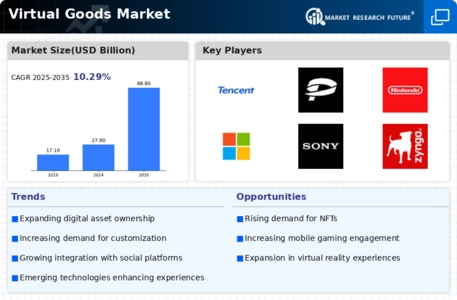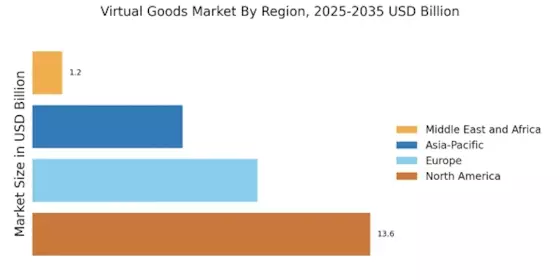Rise of Blockchain Technology
The integration of blockchain technology into the Virtual Goods Market has introduced new paradigms for ownership and authenticity. Blockchain enables the creation of non-fungible tokens (NFTs), which provide verifiable ownership of digital assets. This innovation has attracted significant attention from both consumers and investors, as it offers a new way to buy, sell, and trade virtual goods. Data indicates that the NFT market has seen explosive growth, with sales reaching billions of dollars in recent years. This trend suggests that blockchain could redefine the Virtual Goods Market, as it allows for greater transparency and security in transactions, potentially increasing consumer confidence and driving further investment in virtual goods.
Expansion of Social Media Platforms
The proliferation of social media platforms has significantly influenced the Virtual Goods Market. These platforms have become venues for the exchange and promotion of virtual goods, allowing users to showcase their digital assets. For instance, the introduction of features that enable users to purchase and trade virtual items has created new revenue streams for both platforms and developers. Data suggests that social media users are increasingly willing to spend on virtual goods, with estimates indicating that this segment could account for over 30% of total virtual goods sales. This trend highlights the potential for social media to act as a catalyst for growth within the Virtual Goods Market, as users seek to enhance their online identities through digital purchases.
Growing Interest in Digital Fashion
The increasing interest in digital fashion has emerged as a notable driver for the Virtual Goods Market. As consumers seek to express their identities in virtual spaces, the demand for digital clothing and accessories has surged. This trend is particularly evident in online gaming and social media platforms, where users are willing to invest in unique virtual outfits for their avatars. Recent studies indicate that the digital fashion market could reach a valuation of several billion dollars within the next few years. This growth reflects a broader cultural shift towards the acceptance of virtual goods as a legitimate form of self-expression. Consequently, the Virtual Goods Market is likely to benefit from this trend, as brands and designers explore innovative ways to engage consumers through digital fashion.
Increased Adoption of Online Gaming
The rise in online gaming participation has been a pivotal driver for the Virtual Goods Market. As more individuals engage in gaming, the demand for virtual goods, such as skins, avatars, and in-game currency, has surged. Recent data indicates that the online gaming sector has seen a growth rate of approximately 10% annually, leading to a corresponding increase in virtual goods transactions. This trend suggests that as gaming becomes more mainstream, the Virtual Goods Market will likely experience sustained growth, driven by the need for personalization and enhanced gaming experiences. Furthermore, the integration of social features in gaming platforms has encouraged players to invest in virtual goods, thereby solidifying their presence in the market.
Emergence of Virtual Reality Experiences
The advent of virtual reality (VR) technology has opened new avenues for the Virtual Goods Market. As VR becomes more accessible, the demand for immersive experiences has led to an increase in the purchase of virtual goods tailored for these environments. Reports indicate that the VR market is projected to grow at a compound annual growth rate of 25%, which bodes well for the virtual goods associated with these experiences. Users are likely to invest in virtual items that enhance their interactions within VR settings, such as virtual clothing or accessories. This trend suggests that the Virtual Goods Market will continue to evolve, driven by technological advancements that create richer, more engaging user experiences.


















Leave a Comment